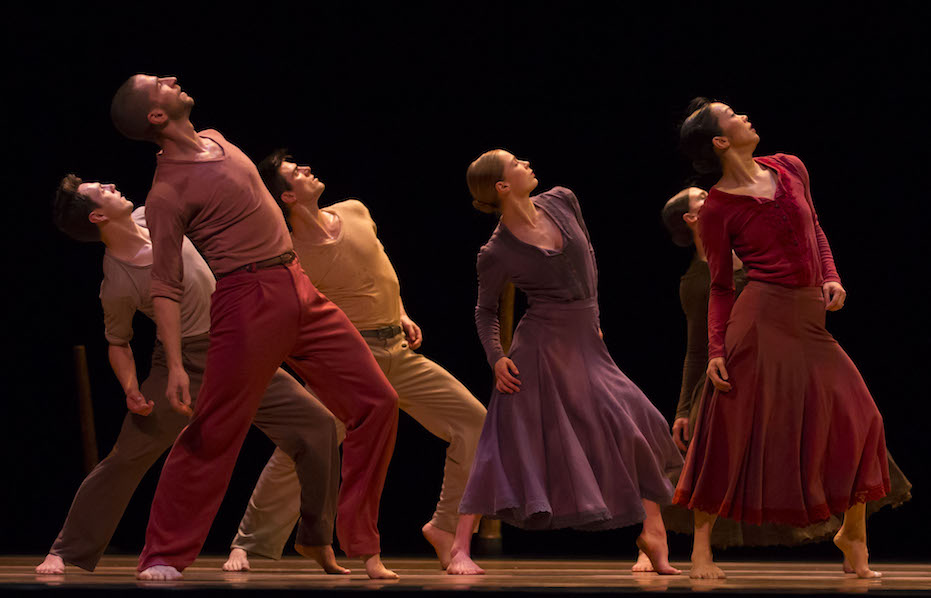Cal Performances brings many wonderful dance companies to Zellerbach Hall, and Hubbard Street Dance Chicago is one of them. The Chicago–based contemporary dance company presented two programs this past weekend, along with a community dance class on Saturday morning.
Friday’s performance opened with three short pieces with choreography by Nacho Duato, William Forsythe and Alejandro Cerrudo. Unlike many smaller companies that perform works primarily by their founding artistic directors, Hubbard Street Dance has worked with myriad composers since the 1990s. Nacho Duato is one of their earliest and most frequent collaborators.

Duato’s first venture into choreography, the lovely Jardí Tancat, was also one of the first pieces the HSDC performed when it ventured past the choreography of its 1977 founder Lou Conte. The 1983 ballet was originally choreographed for Nederlands Dans Theater and can be seen as a tribute to the people of the land and islands of eastern Spain. Three couples dance on a stark stage with only barren stakes scattered in a line, upright across the floor. They are huddled, bent over, their costumes neutral and earthy in color, terra cotta, dove gray, the pastel shade of the sea on an overcast day. At first there is no music, only the a cappella rustle of long skirts and the rhythm of footfalls. As the dancers move it seems they are bound to the earth. And then the insistent raw voice of Mallorcan singer Maria del Mar Bonet breaks the quiet. While the voice and the dancers portray the people’s struggles with and escapes from the travails of the earth, they also frame their continuing return.
William Forsythe’s “N.N.N.N.” opens with dancer Kevin Shannon on an empty stage. He swings his arm, looking at it as if it were a separate object, hinged and mysterious. He throws his hand upward and lets it settle upright at the end of his arm, elbow flexed. The moment is comic, but he continues. He seems to ask, What is this mysterious beast that is my arm, my hand? Three other dancers enter, and they also seem entranced and absorbed by the movements of a single arm. Thrown out straight, the arm leads on, then swings and lands, elbow bent, with the hand on top of a head, like a jelly fish or an oddly sticky but prescient creature. Soon the dancers are interacting, led and chased by their body’s own recalcitrant parts. Sometimes it’s a hand or a leg that seems to have a life of its own, more often it’s an arm.
As the interaction speeds up to wilder and wilder tempos, the dancers make their own music of sighs, hisses, huffs and puffs. The music by Thom Willems is played so low that it’s barely audible and exists on a subliminal level. In Forsythe’s instructions to the dancers he specifies that they change the dynamics of the piece with each performance, so that sections are faster or slower, depending on the dancers’ moods. This is an extraordinary instruction, requiring that the dancers depend on their knowledge of his (always) very complex choreography and their intuitions about each other’s bodies and movements in space and their trust in that sensitivity.
The first half closed with Alejandro Cerrudo’s “Lickety Split,” which was created specifically for HSDC, premiering in 2006. Set to songs by Devendra Barnhardt, the piece investigates love, with very direct symbolic movements, followed by more abstract and contemporary dance. In that lunge, with his hands to his chest, is he offering his heart? Is her turning away with a leap an ecstatic moment of victory? Elliot Hammans danced a long and beautifully realized solo; most of the ballet is comprised of duets, oozing charm and ebullience.
“Grace Engine” comprised the second half of the program. The long piece, set to music by Owen Belton by Canadian choreographer Crystal Pite, was a darker look at a more frenetic version of life. Stop action and mime counter the fluidity of dance. A woman mimes yelling at a crowd and the crowd rolls away like leaves in wind. A line of lights turns the dancers’ bodies first into ghostly specters, then into flat silhouettes of living breathing people. With the entire 16-person company dressed in suits the ballet company presented a danced interpretation of the competition and agitation that torments us in our 21st-century urban lives. All beautifully danced.
– Jaime Robles
